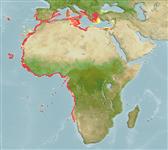Environment: milieu / climate zone / depth range / distribution range
Ökologie
seewasser benthopelagisch; ozeanodrom (Ref. 51243); tiefenbereich 30 - 500 m (Ref. 3198). Subtropical; 42°N - 22°S, 26°W - 36°E
Eastern Atlantic: off Portugal and Strait of Gibraltar to Namibia, including Cape Verde and the Canary Islands. Also from the Mediterranean.
Length at first maturity / Size / Gewicht / Alter
Maturity: Lm 10.8, range 14 - ? cm
Max length : 65.0 cm TL Männchen/unbestimmt; (Ref. 3397); common length : 30.0 cm TL Männchen/unbestimmt; (Ref. 2683)
Rückenflossenstacheln (insgesamt): 11 - 12; Rückenflossenweichstrahlen (insgesamt): 10-11; Afterflossenstacheln 3; Afterflossenweichstrahlen: 8. Body and fins reddish; anal fin and lower part of caudal fin edged with white.
Inhabit rocky or sandy bottoms; individuals descending to greater depths with growth. The stocks migrate seasonally between the coast and deeper waters in accordance with local hydrographic conditions and their life cycle. Feed mainly on fish and crustaceans; the young on plankton (Ref. 3688). Gonochorists (Ref. 4781).
Bauchot, M.-L. and J.-C. Hureau, 1990. Sparidae. p. 790-812. In J.C. Quero, J.C. Hureau, C. Karrer, A. Post and L. Saldanha (eds.) Check-list of the fishes of the eastern tropical Atlantic (CLOFETA). JNICT, Lisbon; SEI, Paris; and UNESCO, Paris. Vol. 2. (Ref. 3688)
IUCN Rote Liste Status (Ref. 130435)
Bedrohung für Menschen
Harmless
Nutzung durch Menschen
Fischereien: kommerziell; Sportfisch: ja
Mehr Information
ReferenzenAquakulturAquakultur ProfilZuchtlinienGenetikElectrophoresesVererbbarkeitKrankheitenVerarbeitungNutrientsMass conversion
PartnerBilderStamps, Coins Misc.LauteCiguateraGeschwindigkeitSchwimmstilKiemenoberflächeOtolithsGehirngrößeSehfähigkeit
Tools
Zusatzinformationen
Download XML
Internet Quellen
Estimates based on models
Preferred temperature (Ref.
123201): 13 - 16.8, mean 14.9 °C (based on 168 cells).
Phylogenetic diversity index (Ref.
82804): PD
50 = 0.5001 [Uniqueness, from 0.5 = low to 2.0 = high].
Bayesian length-weight: a=0.01148 (0.00900 - 0.01464), b=3.03 (3.00 - 3.06), in cm total length, based on LWR estimates for this species (Ref.
93245).
Trophic level (Ref.
69278): 3.5 ±0.44 se; based on food items.
Widerstandsfähigkeit (Ref.
120179): mittel, Verdopplung der Population dauert 1,4 - 4,4 Jahre. (K=0.16-0.25; tmax=13; tm=2).
Prior r = 0.98, 95% CL = 0.65 - 1.47, Based on 1 stock assessment.
Fishing Vulnerability (Ref.
59153): Moderate to high vulnerability (54 of 100).
Climate Vulnerability (Ref.
125649): Low vulnerability (13 of 100).
Nutrients (Ref.
124155): Calcium = 51 [29, 94] mg/100g; Iron = 1.01 [0.58, 1.75] mg/100g; Protein = 19.3 [17.7, 20.7] %; Omega3 = 0.452 [0.262, 0.807] g/100g; Selenium = 43.7 [22.3, 85.4] μg/100g; VitaminA = 17.4 [5.7, 51.2] μg/100g; Zinc = 0.637 [0.453, 0.886] mg/100g (wet weight); based on
nutrient studies.
